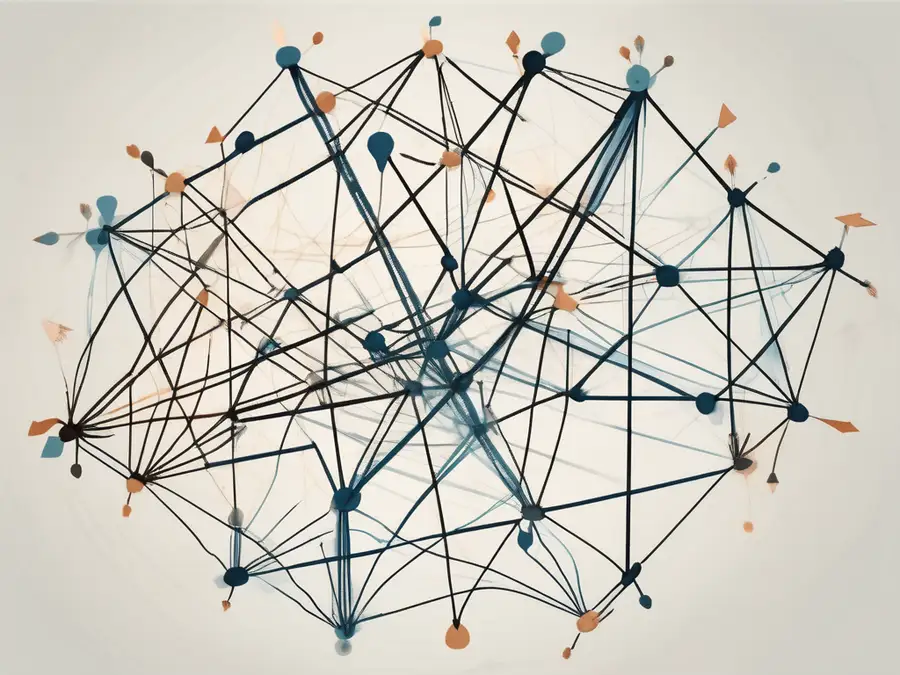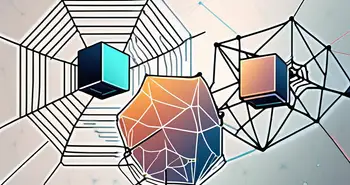Directed Acyclic Graphs (DAG): Revolutionizing Blockchain Technology

In today's technology-driven world, where data structures and algorithms play a crucial role, directed acyclic graphs (DAGs) have become the go-to choice for many applications. Whether you're a seasoned programmer or a curious learner, this ultimate guide will take you on a deep dive into the world of DAGs. So fasten your seat belts, and let's embark on this exciting journey!
Understanding the Basics of Directed Acyclic Graph (DAG)
Before we delve into the intricacies of DAGs, let's start by understanding its fundamental concepts. A Directed Acyclic Graph is a collection of nodes connected by edges, where the edges have a specific direction. The ‘directed' aspect means that the edges have a particular orientation, indicating a specific relationship between the nodes. The ‘acyclic' attribute implies that there are no cycles or loops in the graph, meaning that you cannot traverse a path that leads back to the starting node.
Definition and Characteristics of DAG
At its core, a Directed Acyclic Graph is a finite set of nodes and edges, where each edge connects two distinct nodes, one being the source and the other being the destination. The direction of the edges signifies the flow of information or dependencies between the nodes. This property makes DAGs an excellent choice for modeling complex relationships in various domains, including computer science, mathematics, and biology.
One essential characteristic of DAGs is their non-looping nature. This quality ensures that a specific node does not have a path leading back to itself. This property is especially useful in scenarios where cyclic dependencies can create havoc, such as in scheduling tasks, performing computations, or even in software development projects.
Importance and Applications of DAG
Directed Acyclic Graphs have garnered immense importance in a wide range of applications across different domains. In the field of software engineering, DAGs are commonly employed in build systems, dependency management, and version control systems. They help track and manage complex relationships between software components, ensuring efficient building and deployment processes.
In mathematics and computer science, DAGs are extensively used in various graph algorithms, such as topological sorting and shortest path algorithms. These algorithms rely on the inherent properties of DAGs to perform efficient computations. Moreover, DAGs find applications in data processing pipelines, workflow management systems, and even genetics, where they model gene regulatory networks.
Components of a Directed Acyclic Graph
Now that we have a solid understanding of DAGs, let's explore the components that constitute this versatile data structure.
Nodes in DAG
Nodes, also known as vertices, are the fundamental building blocks of any directed acyclic graph. Each node represents a distinct entity or element in the system being modeled. For example, in a software project, nodes could represent source code files or functions. These nodes carry valuable information and can be connected to other nodes via edges to establish relationships.
It is worth mentioning that nodes can have different properties or attributes associated with them, providing additional context or metadata. These attributes can further enhance the efficiency and utility of DAGs in diverse applications.
Edges in DAG
Edges in a Directed Acyclic Graph define the relationships between the nodes. They embody the directed nature of the graph, indicating the flow of information or dependencies. Each edge has a source node and a destination node, representing the directionality of the relationship. It is crucial to note that the edges in a DAG must adhere to the acyclic property, meaning that they should not form any loops or cycles.
Edges can also carry additional information, weights, or labels, depending on the specific use case. For instance, in a project management scenario, edges could indicate task dependencies, timelines, or even communication channels between team members.
Operations on Directed Acyclic Graphs
Now that we have explored the key components of a DAG, it's time to dive into the operations that can be performed on these graphs.
Creating a DAG
Creating a Directed Acyclic Graph involves adding nodes and establishing connections between them using edges. This process can be done manually, where you define the relationships and assign properties to the nodes and edges. Alternatively, there are also various algorithms and libraries available that can assist in generating DAGs automatically based on a given set of rules or constraints.
As an expert in DAGs, I recall a particular project where we used a DAG to model a complex data pipeline. The DAG allowed us to visualize the data flow and efficiently process large volumes of information. It was fascinating to witness how the DAG structure simplified the development process and improved the overall system performance.
Traversing a DAG
Traversing a Directed Acyclic Graph involves visiting each node and processing the information associated with it. There are several traversal algorithms available, with the most commonly used being topological sorting. Topological sorting ensures that nodes are visited in a specific order based on their dependencies, allowing for efficient processing and avoiding conflicts.
During my journey as a DAG enthusiast, I encountered a scenario where we needed to traverse a large DAG to validate the execution order of a series of dependent tasks. By leveraging the topological sorting algorithm, we successfully determined the correct execution sequence, eliminating any potential bottlenecks and ensuring smooth task completion.
Modifying a DAG
Modifying a Directed Acyclic Graph involves making changes to the structure or properties of the nodes and edges. This could include adding or removing nodes, creating or deleting edges, or modifying the attributes associated with the components. It is crucial to ensure that any modifications to the DAG preserve the essential characteristics of being acyclic and accurately represent the relationships in the system.
Based on my experience with DAGs, I recall a fascinating project where we had to dynamically update a DAG based on real-time data. This allowed us to adapt our system to changing requirements and efficiently respond to evolving dependencies. The flexibility offered by DAGs proved invaluable in achieving our goals.
Algorithms for Directed Acyclic Graphs
Directed Acyclic Graphs serve as the foundation for several fundamental graph algorithms, enabling efficient computations and optimizations. Let's take a closer look at two significant algorithms in the context of DAGs.
Topological Sorting in DAG
Topological sorting is an algorithm that assigns a linear ordering to the nodes in a Directed Acyclic Graph. This ordering ensures that for every directed edge from node A to node B, A appears before B in the ordering. This algorithm is notably useful in determining the execution sequence of dependent tasks, scheduling events, and resolving interdependencies between modules in software systems.
By employing topological sorting, we can optimize the execution flow and avoid circular dependencies. This algorithm has numerous real-world applications, including project management, task scheduling, and even optimizing compiler operations.
Shortest Path Algorithms for DAG
Shortest path algorithms aim to find the most efficient path between two nodes in a graph. In the case of Directed Acyclic Graphs, specialized algorithms, such as the Shortest Path Faster Algorithm (SPFA), can be utilized to find the shortest path from a single source node to all other nodes efficiently.
These algorithms are employed in various domains, including logistics, network routing, and transportation planning. By leveraging the acyclic property of DAGs, these algorithms can provide optimal routes, minimizing costs or maximizing efficiency.
DAG in Data Structures
Beyond their applications in graph algorithms, Directed Acyclic Graphs have found their way into various data structures, serving as the backbone for efficient operations. Let's explore a couple of such scenarios.
Binary Trees as DAG
Binary trees, one of the most prevalent data structures, can be interpreted as a special case of a Directed Acyclic Graph. The nodes in the tree represent entities, and the edges define parent-child relationships. The acyclic nature of binary trees ensures that no node can have a path leading back to itself, preserving the integrity of the structure.
This representation allows for efficient traversal and searching operations, facilitating algorithms like binary search and balanced tree operations. Understanding the inherent DAG nature of binary trees can aid programmers in designing optimized algorithms and data structures.
Heap as a DAG
In the realm of data structures, heaps are another fascinating example of utilizing the properties of DAGs. A heap is a specialized tree-based structure, frequently employed in priority queues and sorting algorithms. Each node in the heap has a specific value or priority associated with it, and the edges maintain the heap property.
By leveraging the acyclic and specific ordering properties of DAGs, heaps ensure efficient insertion, deletion, and retrieval of elements. Understanding this DAG relationship enables developers to create optimal heaps and utilize them to their full potential.
FAQ
What is a Directed Acyclic Graph (DAG)?
A Directed Acyclic Graph is a collection of nodes connected by edges, where the edges have a specific direction. The graph is acyclic, meaning that there are no loops or cycles in the structure. DAGs are widely used to model complex relationships and dependencies in various fields, including software engineering, mathematics, and genetics.
What are the key components of a Directed Acyclic Graph?
The key components of a Directed Acyclic Graph include nodes (vertices) and edges. Nodes represent distinct entities or elements, while edges define the directed relationships between the nodes. Nodes can have associated attributes, and edges can carry additional information or weights.
What operations can be performed on a Directed Acyclic Graph?
Operations on Directed Acyclic Graphs include creating the graph, traversing the graph using algorithms like topological sorting, and modifying the graph structure or attributes. Efficient algorithms exist for various tasks, such as finding the shortest path between nodes and assigning a linear ordering to the nodes.
What are some practical applications of Directed Acyclic Graphs?
Directed Acyclic Graphs find applications in build systems, dependency management, and version control systems in software engineering. They are also used in data processing pipelines, workflow management systems, logistics planning, and genetics. Their versatility makes them an indispensable tool across numerous domains.
Are there any variations of Directed Acyclic Graphs?
While the basic structure of Directed Acyclic Graphs remains the same, there are variations and specialized forms. For example, binary trees can be interpreted as DAGs, and heaps utilize the DAG properties for efficient operations. These variations demonstrate the adaptability and universality of DAGs in numerous scenarios.
What makes Directed Acyclic Graphs essential in the field of graph algorithms?
The directed and acyclic properties of DAGs enable the development of efficient graph algorithms, such as topological sorting and shortest path algorithms. By leveraging these properties, complex problems in tasks scheduling, project management, and network routing can be solved optimally and with computational efficiency.
As an expert in Directed Acyclic Graphs, this guide has been designed to equip you with the knowledge and understanding necessary to comprehend the significance and potential of this powerful data structure. Armed with this understanding, you can confidently tackle a wide range of problems and explore the vast applications in various fields. So go forth, unleash the power of DAGs, and witness their transformative impact in your projects and endeavors!
Ready to apply the principles of Directed Acyclic Graphs to the world of trading? Join Morpher, the innovative trading platform that harnesses the power of blockchain technology to offer you a seamless, fee-free trading experience across a multitude of markets. With Morpher, you can enjoy fractional investing, short selling without interest fees, and up to 10x leverage to enhance your trading strategies. Embrace the future of investing with a platform that provides infinite liquidity and a unique trading experience. Sign Up and Get Your Free Sign Up Bonus today, and take the first step towards a more democratic and flexible trading journey with Morpher.

Disclaimer: All investments involve risk, and the past performance of a security, industry, sector, market, financial product, trading strategy, or individual’s trading does not guarantee future results or returns. Investors are fully responsible for any investment decisions they make. Such decisions should be based solely on an evaluation of their financial circumstances, investment objectives, risk tolerance, and liquidity needs. This post does not constitute investment advice.

Painless trading for everyone
Hundreds of markets all in one place - Apple, Bitcoin, Gold, Watches, NFTs, Sneakers and so much more.

Painless trading for everyone
Hundreds of markets all in one place - Apple, Bitcoin, Gold, Watches, NFTs, Sneakers and so much more.









